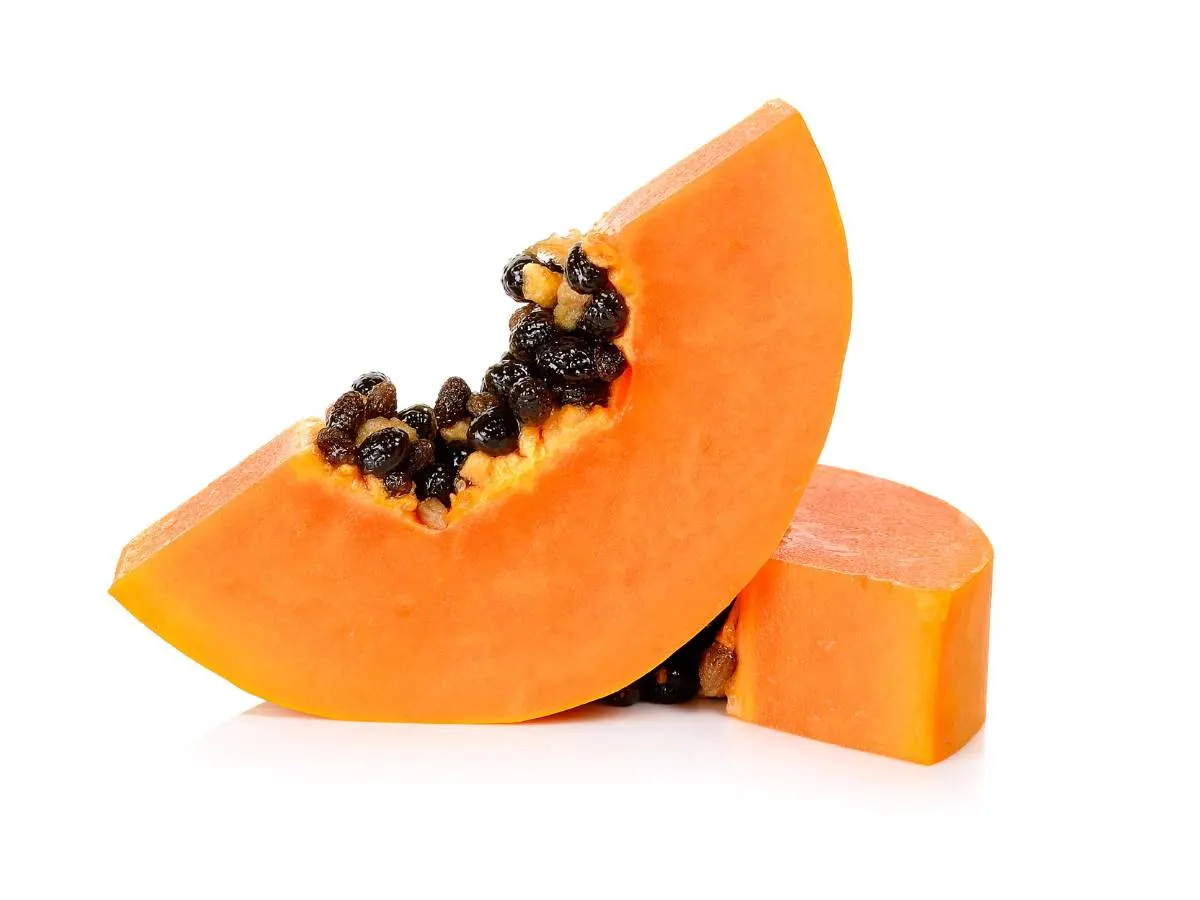Papaya is a delicious tropical fruit that is rich in essential vitamins and minerals. The fruit is so tasty that your Labrador might even beg you for a bite like my dogs often do. However, you should know whether papaya is good for dogs. So, can Labradors eat papaya?
Labradors can eat papaya, provided that the seeds and skin are removed. This fruit contains crucial nutrients, antioxidants, and fiber, which can improve your dog’s digestive health and immunity. However, since it has a high sugar content, you should only feed a few pieces.
Are you interested in enhancing your Labrador’s meal with additional color and flavor? Papaya can be an excellent option, but it’s essential to take your time and learn more about this fruit, including its nutritional benefits and potential feeding risks.
This article will delve into every detail of papaya to ensure you can safely feed it to your Labrador Retriever.
Let’s get started!

Can Labradors Eat Papaya?
Papaya is good for Labradors. It can be a healthy and nutritious treat. Papaya is abundant in vitamins, minerals, and fiber. Although fresh papaya is safe, the fruit contains some natural sugars, and overeating papaya might cause an upset stomach.
Start with a modest amount of papaya and observe your Labrador’s reaction before increasing the amount. Before giving it to your dog, don’t forget to remove the skin and seeds because the seeds could clog the digestive system. The skin may also be problematic for them to digest.
Below is a table providing some essential elements, as recommended by the US Department of Agriculture, to help you better understand the nutritional value of papaya:
| Nutrient | Amount per 100g |
|---|---|
| Calories | 43 |
| Protein | 0.5g |
| Fat | 0.3g |
| Carbohydrates | 11g |
| Fiber | 1.7g |
| Sugar | 7g |
| Vitamin C | 60.9mg |
| Vitamin A | 950IU |
| Folate | 38mcg |
| Potassium | 182mg |
| Magnesium | 21mg |
It’s worth noting that the nutritional content of papaya may vary depending on factors such as ripeness and growing conditions.
Keep in mind that while papaya is generally good for Labradors, it doesn’t mean that’s all they should be eating. Their entire health depends on eating a well-balanced diet that includes a variety of foods that satisfy their nutritional requirements.

Benefits & Risks of Papaya For Labradors
Papaya is a yummy and nutritious fruit, but you may wonder whether it suits your Labrador. I double-checked with my vet if papaya is safe since my Labradors love guzzling it during hot weather.
As Labrador owners, we must make the right decisions. Or else a mistake can be costly.
Benefits of Papaya for Labradors:
- Antioxidant-rich: This refreshing fruit contains antioxidants that can help protect your Labrador’s cells from damage caused by free radicals.
- Boosts immune system: Papaya is abundant in Vitamin A, which can strengthen your dog’s immune system and help it fight infections and diseases.
- Aids digestion: Papaya contains enzymes that can aid your dog’s digestive system, making it an excellent supplement if your Labrador has digestive problems.
- Provides energy: Ripe papaya has natural sugars that can give your dog a quick energy boost.
Risks of Papaya for Labradors:
- Unripe papaya: Don’t feed your Labrador unripe papaya, as it has a compound that can harm dogs. Ensure the fruit is soft and ripe before giving it to your pet.
- Excess sugar: While natural sugars in ripe papaya can be worthwhile in moderation, consuming too much can lead to weight gain and health problems in your pet. Limit the amount your Lab eats to prevent any possible issues.
- Seeds and skin: Your dog could choke on papaya seeds or skin. Before feeding the fruit to your Labrador, make sure to remove these parts.
If you feed papaya to your Labrador Retriever, you can use it as a topping on their regular food to enhance flavor. This will serve its purpose, and your furry friend will love the taste.
More benefits, less risks!

Feeding Papaya To Labradors
Papaya is good for dogs. A study found that papaya plants had an anti-filarial effect. On the other hand, a veterinarian has stated that fresh papaya can occasionally be fed, but that doesn’t apply to other parts of the fruit.
If your Labrador has a digestive issue or diabetes, check with your vet before feeding papaya. It clears the GI tract only for humans.
So, how do you ensure safe feeding?
To feed papaya safely to your Labrador, follow these basic steps:
- Choose ripe papaya: Ensure it is ripe by checking its skin color. A ripe papaya has yellow-orange skin, while an unripe one is green. Feeding unripe papaya to your dog may cause indigestion.
- Clean the papaya: Wash the papaya thoroughly to get rid of any dirt or chemicals. You must clean the fruits you use before giving them to your pet, even if they are organic.
- Remove the seeds: Before cutting the papaya, take caution to remove the seeds because your Labrador could choke on them. The seeds are easy to remove using a spoon.
- Cut the papaya into small pieces: To avoid choking, cut the papaya into small, bite-sized pieces suitable for your pet’s size. Ensure the chunks are easy for your Labrador to chew and swallow.
- Feed sparingly: While papaya is a healthy snack for dogs, you must feed it in moderation. Overfeeding can lead to digestive problems. Use papaya as an occasional reward, not as a replacement for your dog’s regular meal.
To help you judge the ideal quantity of papaya for your Labrador Retriever, refer to this handy table:
| Age of Labrador | Ideal Amount of Papaya |
|---|---|
| Puppy (3-6 months) | 1-2 small pieces |
| Juvenile (6-12 months) | 2-4 small pieces |
| Adult (1-6 years) | 3-6 small pieces |
| Senior (7+ years) | 2-4 small pieces |
Feeding papaya to your Labrador can be an enjoyable and nutritious experience as long as you follow these guidelines. Enjoy sharing this fruity treat with your best friend!

What Signs Point to a Poor Papaya Response in Dogs?
Although papayas are typically considered healthy for dogs, certain Labradors may react negatively or even have an allergy to this fruit. Understanding the warning signals of a poor reaction might help you spot and fix the issue immediately.
A Labrador may display the following symptoms if they’re having a bad reaction to papaya:
- Upset stomach
- Diarrhea
- Vomiting
- Swelling of the face, ears, or tongue
- Itchy skin or hives
Whenever you observe any of these signs, you should act quickly. Based on my experiences at my shelter, I’ve listed the action plan for every symptom.
| Symptom | What to Do |
|---|---|
| Diarrhea | Ensure your Lab stays hydrated and monitor their condition for any further deterioration. If it continues, consult a veterinarian. |
| Upset stomach | Let your dog rest, and deprive him of food for 12 to 24 hours. Once symptoms have disappeared, gradually reinstate a plain diet once more. |
| Vomiting | Keep an eye on and keep track of your dog’s health. See a veterinarian if symptoms intensify or disappear within a day. |
| Itchy skin or hives | Monitor your pet’s condition. If symptoms worsen or do not subside within a day, seek veterinary advice. |
| Swelling of the face, ears, or tongue | This may be a sign of an allergic reaction and requires immediate veterinary attention. |
Early intervention can help prevent further complications and ensure your Labrador remains happy and healthy.
Alternatives to Papaya
Are you not convinced about feeding papaya to your Labrador? Let’s head on to other nutritious alternatives. Of course, they’re healthy as well!
- Apple: Apples are a great source of vitamins A and C and fiber. They can be a crunchy and juicy treat for your Labrador. You should remove the core and seeds, as they can harm your pet.
- Pear: Similar to apples, pears are rich in vitamins and fiber. Remove the seeds and core before giving your dog a delicious slice of fresh pear.
- Blueberries: Packed with antioxidants and vitamins, blueberries make a tasty snack for your Labrador. They are small enough to be fed whole or mixed into your dog’s food.
- Melon: Watermelon, honeydew, and cantaloupe are all delicious hydrating options for your Labrador. Just make sure you remove any seeds and rind before serving.
- Strawberries: Rich in antioxidants, strawberries are a sweet and healthy treat. Offer the fruit sliced or mashed to make it easier for your dog to enjoy.
- Pineapple: Pineapple is a sweet and juicy treat that can provide your pup with vitamins A, C, and B6, dietary fiber, ensuring good digestive health and a robust immune system. They also contain bromelain, which is good for skin issues.
- Banana: Providing natural sugars and essential nutrients, bananas can be a sweet treat for your best friend. Slice or mash a small amount, and don’t feed the peel to prevent digestive issues.
- Fig: Figs are rich in nutrients and make a great treat when offered sparingly. Remove the skin and serve the flesh in small pieces to ensure easy digestion.
- Tomato: Ripe tomatoes contain many vitamins and minerals, but avoid feeding unripe, green tomatoes, as they can be poisonous. Give a small slice or mash a bit of ripe tomato as a tasty addition to your pup’s food.
- Cucumber: As a low-calorie snack, cucumber is perfect for keeping your Labrador hydrated and refreshed. Cut it into slices or small chunks for easy consumption.
Remember to slowly and moderately introduce new fruits or veggies to prevent any tummy troubles. Your Labrador can enjoy a diverse and healthy diet with these tasty alternatives.
FAQs
Can papaya be used as a remedy for digestive issues in dogs?
Papaya can benefit dogs with digestive issues, including constipation and diarrhea. The fruit contains enzymes that can help break down proteins and aid digestion, making it a natural way to help relieve symptoms. Papaya may also help with diarrhea in dogs due to its high fiber content.
Are there any Labradors who should not eat papaya?
While papaya is considered safe for Labradors, some dogs should not consume the fruit. Dogs with certain medical conditions, such as diabetes or pancreatitis, may not be able to tolerate the high sugar content in papaya. Additionally, dogs with allergies or sensitivities to papaya should avoid the fruit.
Can feeding my Labrador papaya help with bad breath?
Papaya has been suggested as a natural remedy for bad breath in dogs. The enzymes in the fruit can help break down food particles and reduce the buildup of bacteria in the mouth, which can contribute to bad breath. However, bad breath can also indicate underlying dental or health issues, so consult your vet if your dog has persistent bad breath.

